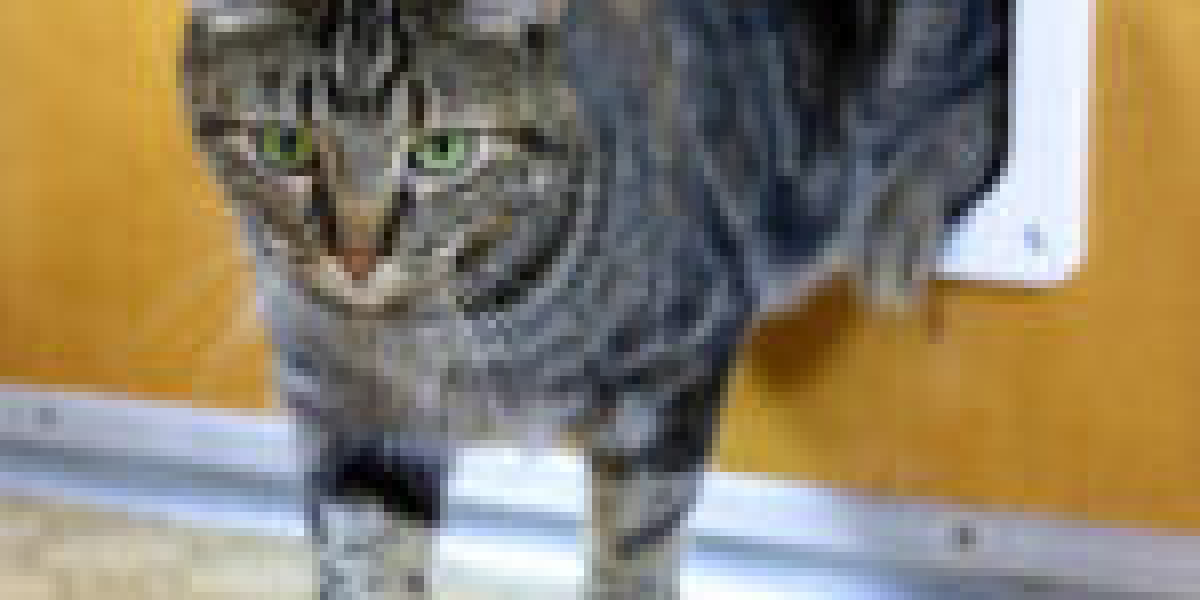
Keeping the Purrfect Passage Open: A Guide to Cat Door Maintenance
Cat doors, also called pet doors or cat door for wooden door flaps, are a wonderful addition to any home with feline companions. They offer felines the freedom to explore the outdoors (or designated areas within your home) and relieve themselves, all while giving owners peace of mind and decreasing the number of impromptu door-opening requests. However, like any other function of a home, cat doors are not immune to wear and tear. Regular maintenance is important to guarantee they continue to operate properly, remain safe and secure, and supply a comfy and safe passage for your cherished cat. Ignoring maintenance can result in a host of concerns, varying from a stiff and noisy flap to a total breakdown, possibly locking your cat out or, even worse, jeopardizing your home's security.
This post will dive into the value of cat door maintenance, detailing the essential steps to keep your pet's access point in prime condition. By comprehending the basic maintenance needed, you can extend the life-span of your cat door, ensure your cat's ongoing liberty, and avoid expensive repair work or replacements down the line.
Why Regular Cat Door Maintenance Matters
Keeping your cat door is more than just a cosmetic task; it's a financial investment in the functionality, security, and durability of the function, as well as the comfort and wellness of your cat. Here are some key reasons routine maintenance is vital:
- Ensures Smooth Operation: Dust, particles, and weather components can accumulate around the hinges and flap of a cat door, triggering it to end up being stiff, sticky, or noisy when opening and closing. Routine cleaning and lubrication prevent these concerns, guaranteeing the door runs smoothly and quietly, encouraging your cat to use it without doubt.
- Extends the Lifespan of the Door: Like any mechanical part, cat doors are subject to wear and tear. Overlooking maintenance can accelerate this process, causing early damage and the requirement for replacement. Regular cleansing, lubrication, and attending to small issues quickly can substantially extend the life expectancy of your cat door, conserving you cash in the long run.
- Maintains Security: A correctly working cat door must close firmly after your cat Flap for Window goes through. Damaged or improperly maintained doors might not close entirely, potentially jeopardizing your home's security by leaving spaces that could be made use of by trespassers or enable drafts and bugs to get in. For electronic or microchip-operated doors, consistent maintenance ensures the locking mechanisms and sensors work reliably, preserving controlled access.
- Prevents Drafts and Energy Loss: A poorly preserved cat door can become a significant source of drafts, specifically in colder environments. Gaps around the flap or frame due to damage or particles can let cold air in and warm air out, increasing your energy costs. Correct sealing and weather removing maintenance is essential to keep energy effectiveness.
- Promotes Hygiene: Cat doors are exposed to the aspects and can build up dirt, mud, and even insect infestations gradually. Regular cleansing assists preserve a hygienic passage for your cat and prevents the transfer of dirt and bacteria into your home.
- Reduces Noise: A disregarded experienced cat flap installer door can become loud, specifically in windy conditions. Squeaking hinges or a rattling flap can be disruptive to both you and your cat. Lubrication and tightening up of loose parts can substantially lower sound levels.
- Early Detection of Problems: Routine maintenance allows you to check your cat door carefully and determine any possible concerns early on, such as cracks, loose screws, or malfunctioning components. Resolving these small issues without delay can prevent them from intensifying into more considerable and pricey repairs.
Types of Cat Doors and Maintenance Considerations
While the fundamental maintenance concepts apply across a lot of cat doors, various types may have particular requirements. Here's a short introduction of common cat door types and maintenance considerations:
- Basic Flap Doors: These are the simplest and most typical type. Maintenance mostly includes cleaning up the flap and frame, lubricating hinges, and inspecting for damage to the flap material (plastic, rubber, or versatile polymer).
- Magnetic Cat Doors: These doors use a magnetic collar secret to permit entry only to cats using the key. Maintenance includes the exact same tasks as basic flap doors, plus guaranteeing the magnetic mechanism is tidy and complimentary of debris. Likewise, examine the collar secret's magnet is still functional.
- Microchip Cat Doors: These doors utilize a microchip scanner to recognize your cat's implanted microchip, using selective entry. Maintenance consists of cleansing, looking for damage, and sometimes replacing batteries if it is battery-powered. The scanner lens should be kept tidy for reputable chip detection.
- Electronic 24/7 cat flap installer Doors: These doors might use infrared or radio frequency (RFID) innovation for selective entry, typically with innovative features like curfew settings. Maintenance includes cleaning, looking for damage, battery replacement (if relevant), and sometimes recalibrating or reprogramming the electronic parts according to the maker's directions.
Important Cat Door Maintenance Tasks: A Step-by-Step Guide
Establishing a routine maintenance schedule will keep your cat door functioning efficiently. Here's a breakdown of typical maintenance tasks:
1. Routine Cleaning (Weekly/Bi-weekly):
- Gather Supplies: You will require:
- Mild soap or cleaning agent
- Warm water
- Soft fabric or sponge
- Paper towels or a clean, dry cloth
- (Optional) Disinfectant wipes (pet-safe)
- Wipe Down the Flap: Use a wet cloth or sponge with soapy water to clean both sides of the flap. Remove any dirt, mud, fur, or insect residue.
- Tidy the Frame: Clean the whole frame of the cat door, both inside and out. Take notice of corners and crevices where dirt can build up.
- Dry Thoroughly: Ensure all parts are totally dry to avoid mildew or rust.
- Sanitize (Optional): If preferred, utilize pet-safe disinfectant wipes to sterilize the door and frame, especially if you have several felines or desire to keep extra hygiene.
2. Lubrication (Monthly/As Needed):
- Identify Hinges and Moving Parts: Locate the hinges, rotates, or any other moving parts of the cat door mechanism.
- Apply Lubricant: Use a silicone-based lubricant spray or a dry lubricant (like graphite powder) specifically created for hinges and moving parts. Prevent oil-based lubes, as they can draw in dust and end up being sticky in time. Apply sparingly to avoid drips.
- Work the Door: Open and close the cat door flap numerous times to distribute the lube equally and guarantee smooth, peaceful operation. Clean away any excess lube.
3. Evaluation and Repair (Monthly/Seasonally):
- Check for Damage: Carefully check the flap for cracks, tears, or warping. Search for damage to the frame, weather condition stripping, or any locking systems.
- Tighten Up Loose Screws: Check all screws securing the door frame to the door or wall and tighten any that are loose. Loose screws can lead to instability and drafts.
- Inspect Weather Stripping: Examine the weather condition stripping around the flap and frame for damage, cracks, or spaces. Replace damaged weather condition stripping to preserve a good seal and prevent drafts.
- Battery Check (Electronic/Microchip Doors): If your door is battery-operated, check the battery level regularly and change batteries according to the producer's recommendations. Low batteries can trigger breakdowns and unreliable operation.
- Sensor Cleaning (Microchip/Electronic Doors): Gently clean the sensing unit lens with a soft, dry cloth to make sure precise chip or essential detection.
4. Seasonal Maintenance:
- Winter:
- Check for ice buildup around the flap and frame. Carefully get rid of ice to avoid damage and make sure smooth operation.
- Guarantee weather condition stripping is in excellent condition to avoid drafts and cold air entry.
- Summertime:
- Check for insect nests or infestations around the cat door. Tidy away any nests and think about using pet-safe insect repellent around the door frame.
- Make sure proper ventilation around the door opening to prevent humidity buildup and prospective mildew development.
Tools and Supplies for Cat Door Maintenance
Keeping a small kit of maintenance tools and supplies handy will make routine maintenance easier and more effective. Think about assembling the following:
- Soft fabrics and sponges
- Moderate soap or cleaning agent
- Silicone lubricant spray or dry lubricant
- Screwdriver (Phillips and flathead)
- Pet-safe disinfectant wipes (optional)
- Replacement weather condition stripping (if required)
- Small brush for cleaning crevices
- Paper towels
- Replacement batteries (if applicable)
DIY vs. Professional Help
A lot of routine cat door maintenance jobs are uncomplicated and can be easily handled by property owners. Nevertheless, there are scenarios where looking for professional assistance may be advisable:
- Significant Damage: If you discover extensive damage to the door frame, flap, or locking systems, professional repair or replacement might be required.
- Electronic Malfunctions: Troubleshooting electronic or microchip door breakdowns can be complicated. If you are unsure how to diagnose or repair electronic concerns, seek advice from a professional installer or a certified technician.
- Installation Issues: If you are experiencing relentless problems after setting up a new cat door, it may be due to installation mistakes. A professional installer can assess the circumstance and rectify any problems.
Regular cat door maintenance is a simple yet important element of accountable pet ownership for those who choose to supply their feline buddies with this flexibility. By devoting a little quantity of time to cleaning, lubricating, and examining your cat door, you can guarantee its continued smooth operation, durability, security, and hygiene. A well-maintained cat door offers your cat with consistent access to the outdoors world (or designated indoor areas), contributing to their joy and wellness, while likewise supplying assurance for you. Taking proactive actions to take care of your cat door will keep the purrfect passage open for years to come.
Frequently Asked Questions about Cat Door Maintenance
Q: How frequently should I clean my cat door?
A: Aim to clean your cat door weekly or bi-weekly for basic flap doors. For electronic or microchip doors that might build up more dirt around the sensing unit locations, weekly cleansing is recommended.
Q: What kind of lubricant should I use on my cat door hinges?
A: Silicone-based lubricant spray or dry lube (like graphite powder) is suggested. Prevent oil-based lubricants as they can draw in dust and end up being sticky.
Q: How do I clean a microchip cat door sensor?
A: Use a soft, dry fabric to gently wipe the sensor lens. Prevent using liquids or abrasive cleaners, as they might damage the sensor.
Q: My cat door flap is sticking. What should I do?
A: First, tidy the flap and frame thoroughly. Then, use a percentage of lubricant to the hinges and moving parts. If the sticking persists, inspect for any damage to the flap or frame and think about tightening up screws or adjusting the door alignment.
Q: How do I know when to change the batteries in my electronic cat door?
A: Electronic cat doors typically have a low battery sign light or warning signal. Refer to your door's manual for particular instructions on battery replacement. It's an excellent practice to replace batteries proactively, maybe every 6-12 months depending upon usage and battery type.
Q: Can I use home cleaners to clean my cat door?
A: Yes, you can utilize moderate soap or detergent diluted in warm water. Prevent harsh chemicals or abrasive cleaners that might harm the door material. Ensure any cleansing items are pet-safe.
Q: My cat door for wooden door door is letting in drafts. How can I fix this?
A: Inspect the weather stripping around the flap and frame. Change any broken or used weather removing. Make sure the door frame is safely installed and tighten any loose screws. You can also consider adding additional weather stripping or a draft excluder particularly created for pet doors.







